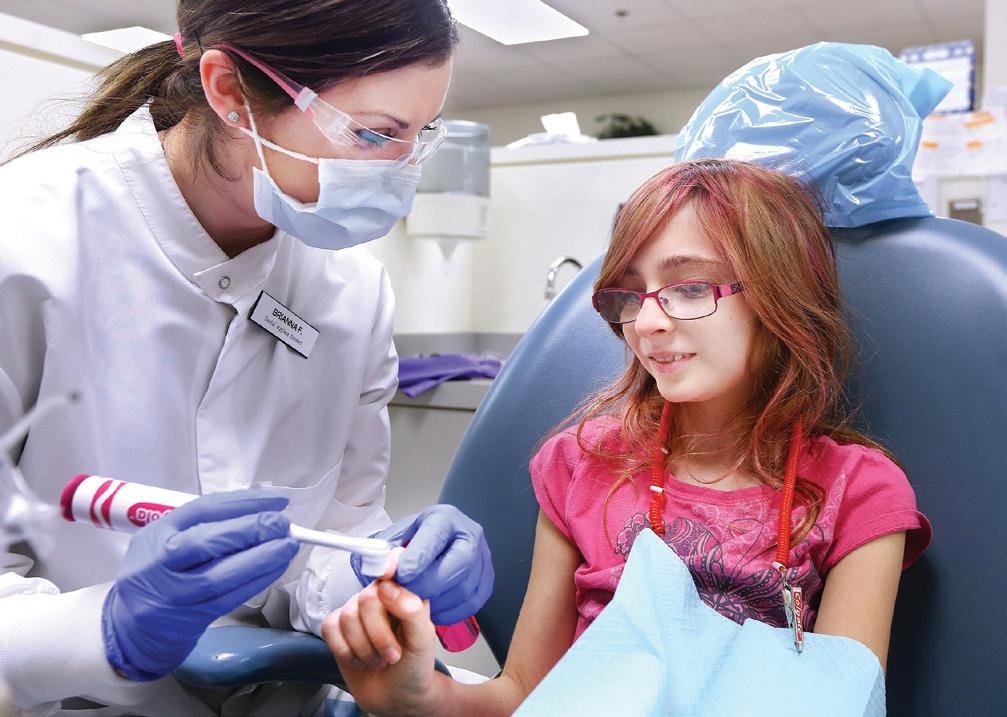
2 minute read
Education is key to improving children’s oral health
BY DR. NICHOLAS MATACK
Dental decay is the most prevalent infectious disease in our country’s youths. Two out of five children will have a cavity before reaching kindergarten. Establishing a positive culture about dental health at home will help your child establish healthy lifelong habits. This process should begin at a young age. A child should see a dentist when the first tooth enters the mouth, or at least before their first birthday, according to the American Academy of Pediatric Dentistry. Typically, these infant exams are done with the child in the parent’s lap. Parental expectations for this first visit should be to establish rapport with the dental team, introduce the child to the dental atmosphere, and most importantly, to deepen parents’ knowledge regarding their child’s dental and oral health.
Hygiene Matters
Having a good oral hygiene regimen starts with understanding how decay happens. Tooth decay is an infectious disease caused by bacteria that produces acid on the tooth surface, or “plaque.” Good hygiene practices help to decrease the buildup of bacterial plaque. There are many types of bacteria in our mouths, but only a specific few are directly tied to tooth decay. Since these bacteria can be spread between parents and siblings, it is important that all family members have good hygiene, to minimize the risk of transmission.
Ideal hygiene practices include brushing for two minutes, twice a day. Children younger than 3 should use no more than a rice-size smear of fluoridated toothpaste. Children ages 3-6 should not use more than a peasize amount. Although it is good to get kids in the habit of brushing their own teeth, young children should have their teeth brushed by an adult to ensure effectiveness. Observe your child’s brushing habits and technique until you can be assured they are independent. Replace you child’s brush every three to four months, when it looks worn, or if the child has been ill. Although brushing with good technique is an effective method to remove plaque from most tooth surfaces, there are some places where a brush cannot reach. Flossing once per day should begin when adjacent teeth are in contact with one another.
Sugar Bugs
Beyond excellent hygiene practices, diet is another major factor that can significantly affect decay risk. The bacteria that causes dental decay turns the same foods that we eat into acids, which then erode our tooth structure, causing a cavity.
Not all foods have the same level of cavity risk. Snacks high in sugar, even natural foods (such as dried fruits) are high-risk for decay. Among the most common offenders are soda, juice, sports drinks and hard candy. These snacks have a high sugar content and are commonly consumed over long periods or frequently throughout the day. The frequency with which we consume high-risk foods is the most important consideration related to decay.
Protective factors in our saliva, and toothpaste can lessen the risk of tooth decay. However, when high-risk foods are consumed frequently, our saliva does not have an opportunity to decrease the eroding effects of acid produced by bacteria. In this sense, it is not the quantity, but the frequency that matters far more. Early childhood decay can occur after the first baby tooth has come into the mouth when children are fed frequently by bottle with milk at night or sippy-cup with juice.
It may be unrealistic to consider completely eliminating all high-risk snacks. However, consuming less sugar-laden snacks, less frequently throughout the day can significantly decrease our risk for dental decay.
Beyond Decay
The dental home that you establish for your kids can provide you with important insights beyond dental decay. Your dentist can be instrumental in recognizing developmental abnormalities, tooth alignment concerns and pathologies of the surrounding area. Habits such as thumb sucking, which can result in altered tooth position and restricted jaw growth, can be discussed. Important points such as the value of baby teeth in maintaining space for adult teeth and health of adult teeth are valuable pearls of knowledge gained through a child’s dental visits.
Establishing a dental home can facilitate the conversations that will lead to education and ultimately the opportunity for better oral health.










